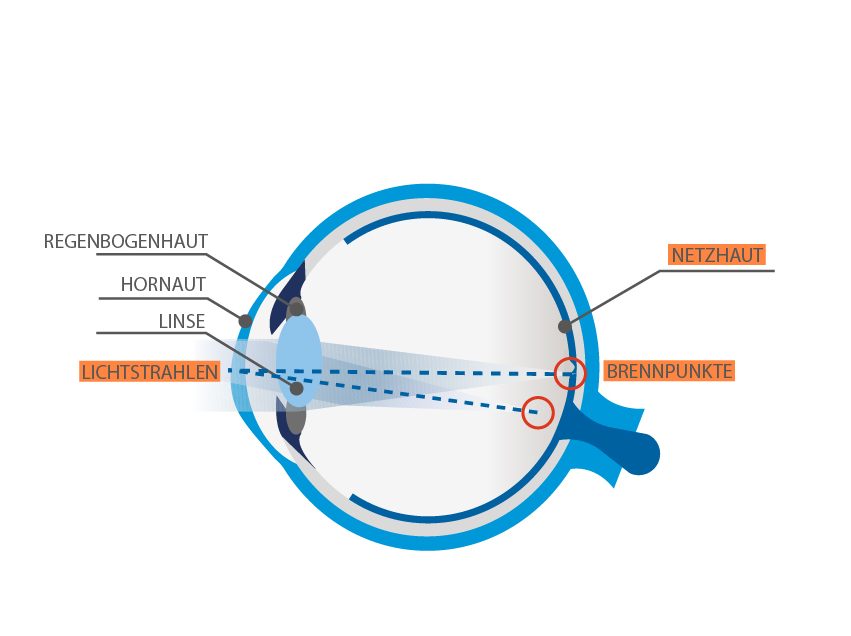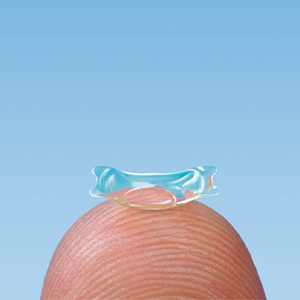How does astigmatism occur?
The cornea is usually almost spherically curved in the horizontal and vertical directions. Thus, the light falls evenly into the eye. In the case of astigmatism, the curvature of the cornea usually deviates from the conventional shape. As a result, the light rays hit the retina at different points – the result is distorted, blurred vision.
There are different forms of astigmatism:
There is regular astigmatism when there is unequal refractive power in two perpendicular planes.
The second form of astigmatism is called irregular astigmatism. This is the case when the refractive power is very different in different parts of the cornea.
Astigmatism is usually congenital. In rare cases, however, scars after a corneal injury can also be a cause.
You cannot prevent the development of astigmatism. However, in children, it is important to recognize and treat or correct them early on.
In many patients, astigmatism is diagnosed together with nearsightedness, farsightedness and/or presbyopia.


What are the symptoms of astigmatism?
Whether and how the affected person notices the astigmatism depends on the severity of the same. If there is only a slight astigmatism, those affected hardly notice it or not at all for years. Greater astigmatism is characterized by blurred vision.
If no correction is made, the astigmatism can lead to headaches or burning eyes. Because the eye then constantly tries to focus the distorted image by adjusting the refractive power.
Possible symptoms of astigmatism are:
- Distorted field of view
- Headaches
- Tired eyes
- Sore eyes
- Burning eyes
Eye laser treatments for astigmatism
Rigid contact lenses or glasses with cylindrical lenses can usually compensate for astigmatism. Many patients opt for laser eye surgery or lens surgery to treat astigmatism.
CARE Vision offers several eye laser procedures for the treatment of astigmatism. If there is another refractive error such as short-sightedness, this can be corrected in the same surgery procedure.

It is not possible to treat astigmatism – what now?
In the case of particularly severe astigmatism (over -6 diopters), the doctor treating you often decides against laser eye treatment. A lens treatment with phakic lenses can then enable a life without glasses.
Astigmatism and other ametropia
Yes, astigmatism and short-sightedness can be corrected in one treatment step, provided you are eligible for eye laser surgery. Many patients have a combination of these two ametropia.
Yes, astigmatism and hyperopia can be corrected in one treatment step if you are eligible for laser vision correction. Many patients have a combination of these two refractive errors.
Frequently asked questions about astigmatism (FAQ)
In most cases, an oval shape of the cornea leads to what is known as astigmatism. The oval or wavy shape, which is often inherent, means that the incident light rays are not optimally refracted. This causes the affected person to see distorted. Points are then perceived as elongated circles or even rods – hence the name “astigmatism”. In rare cases, a curvature of the lens leads to astigmatism. An astigmatism can also occur as a result of an injury to the eye. Astigmatism can occur alone, but also in combination with nearsightedness or farsightedness. Astigmatism can usually be treated very well with an eye laser treatment.
Yes, in most cases an eye laser treatment can compensate for the astigmatism very well. The laser gently models the top layer of the cornea in such a way that the incident light is optimally refracted. If there are other ametropia, such as nearsightedness or farsightedness, these are also compensated for. After a detailed examination of the eyes, the doctor can recommend the most suitable method of treatment for the patient.
Yes, that is possible. This is actually the case in most cases, because the majority of short-sighted patients also suffer from astigmatism. The laser gently models the uppermost layer of the cornea so that short-sightedness and astigmatism can be optimally compensated.
This is largely dependent on the characteristics of the patient’s eye. After a thorough examination of the eyes, the doctor treating you decides whether they are suitable for treatment and which procedure should best be used. Astigmatism can be lasered up to a maximum of 6 diopters by means of laser eye treatment if the eyes are otherwise suitable for the treatment. For example, if the cornea is too thin for an eye laser correction, a lens treatment may achieve optimal results.
Eye laser surgery to correct astigmatism costs around 1.150 euros per eye at CARE Vision (billing is based on the schedule of fees for doctors after the treatment has been completed). It does not matter whether there is also short-sightedness or far-sightedness – this can be compensated for in the same treatment procedure. More information about costs, financing, reimbursement by health insurance companies and tax deductibility can be found here.
